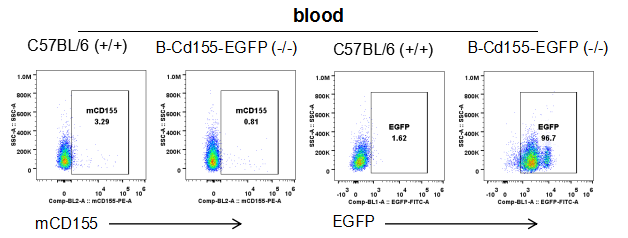Basic Information
Description
Biocytogen designed a targeted mutation mouse named B-Cd155-EGFP KI mice which Cd155 gene was replaced with the EGFP gene.
-
Gene targeting strategy

-
Gene targeting strategy for B-Cd155-EGFP KI mice. The EGFP gene encoding green fluorescent protein was inserted after the 5 ‘UTR sequences of mouse Cd155 gene to replace it in B-Cd155-EGFP mice.
-
Protein expression analysis in B cell

-

Species-specific mCD155 and EGFP protein expression analyses in homozygous B-Cd155-EGFP KI mice by flow cytometry. Spleen, bone marrow, lymph node and blood were collected from wild-type mice (+/+) and homozygous B-Cd155-EGFP KI mice (-/-), and analyzed by flow cytometry with species-specific anti-CD155 and anti-EGFP antibodies. Mouse CD155 was not detectable in B cells of wild-type mice and homozygous B-Cd155-EGFP KI mice. EGFP was detectable in B cells of homozygous B-Cd155-EGFP KI mice.
-
Protein expression analysis in T cell

-

Species-specific mCD155 and EGFP protein expression analyses in homozygous B-Cd155-EGFP KI mice by flow cytometry. Spleen, lymph node, thymic tissue and blood samples were collected from wild-type mice (+/+) and homozygous B-Cd155-EGFP KI mice (-/-), and analyzed by flow cytometry with species-specific anti-CD155 and anti-EGFP antibodies. Mouse CD155 was detectable in T cells of wild-type mice, but not detectable in T cells of homozygous B-Cd155-EGFP KI mice. EGFP was detectable in T cells of homozygous B-Cd155-EGFP KI mice.
-
Protein expression analysis in NK cell

-

Species-specific mCD155 and EGFP protein expression analyses in homozygous B-Cd155-EGFP KI mice by flow cytometry. Spleen, thymus, bone marrow and lymph node samples were collected from wild-type mice (+/+) and homozygous B-Cd155-EGFP KI mice (-/-), and analyzed by flow cytometry with species-specific anti-CD155 and anti-EGFP antibodies. Mouse CD155 was detectable in NK cells of wild-type mice, but not detectable in NK cells of homozygous B-Cd155-EGFP KI mice. EGFP was detectable in NK cells of homozygous B-Cd155-EGFP KI mice.

Species-specific mCD155 and EGFP protein expression analyses in homozygous B-Cd155-EGFP KI mice by flow cytometry. Blood was collected from wild-type mice (+/+) and homozygous B-Cd155-EGFP KI mice (-/-), and analyzed by flow cytometry with species-specific anti-CD155 and anti-EGFP antibodies. Mouse CD155 was not detectable in NK cells of homozygous B-Cd155-EGFP KI mice. EGFP was detectable in NK cells of homozygous B-Cd155-EGFP KI mice.
-
Protein expression analysis in macrophages

-

Species-specific mCD155 and EGFP protein expression analyses in homozygous B-Cd155-EGFP KI mice by flow cytometry. Lavage solution, bone marrow, spleen and blood samples were collected from wild-type mice (+/+) and homozygous B-Cd155-EGFP KI mice (-/-), and analyzed by flow cytometry with species-specific anti-CD155 and anti-EGFP antibodies. Mouse CD155 was detectable in macrophages of wild-type mice, but not detectable in macrophages of homozygous B-Cd155-EGFP KI mice. EGFP was detectable in macrophages of homozygous B-Cd155-EGFP KI mice.
-
Protein expression analysis in monocytes

-

Species-specific mCD155 and EGFP protein expression analyses in homozygous B-Cd155-EGFP KI mice by flow cytometry. Lavage solution, bone marrow, spleen and blood samples were collected from wild-type mice (+/+) and homozygous B-Cd155-EGFP KI mice (-/-), and analyzed by flow cytometry with species-specific anti-CD155 and anti-EGFP antibodies. Mouse CD155 was detectable in monocytes of wild-type mice, but not detectable in monocytes of homozygous B-Cd155-EGFP KI mice. EGFP was detectable in monocytes of homozygous B-Cd155-EGFP KI mice.
-
Protein expression analysis in granulocytes

-

Species-specific mCD155 and EGFP protein expression analyses in homozygous B-Cd155-EGFP KI mice by flow cytometry. Spleen, blood and bone marrow were collected from wild-type mice (+/+) and homozygous B-Cd155-EGFP KI mice (-/-), and analyzed by flow cytometry with species-specific anti-CD155 and anti-EGFP antibodies. Mouse CD155 was detectable in granulocytes of wild-type mice, but not detectable in granulocytes of homozygous B-Cd155-EGFP KI mice. EGFP was detectable in granulocytes of homozygous B-Cd155-EGFP KI mice.
-
Summary

-
Protein expression analysis:
Mouse CD155 was detectable in T cells, NK cells, macrophages, monocytes and granulocytes of wild-type mice, but not homozygous B-Cd155-EGFP KI mice. EGFP was detectable in T cells, NK cells, macrophages, monocytes and granulocytes of homozygous B-Cd155-EGFP KI mice.
Mouse CD155 was not detectable in B cells of wild-type mice and homozygous B-Cd155-EGFP KI mice, but EGFP was detectable in B cells of homozygous B-Cd155-EGFP KI mice. It is speculated that the expression level of CD155 in B cells of wild mice is too low to detect the expression. Or it was speculated that the targeting strategy affected the promoter of CD155, resulting in EGFP expression in B cells.


